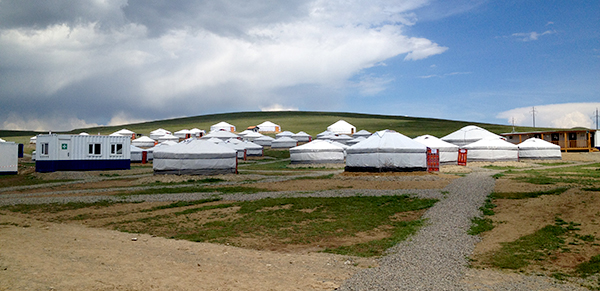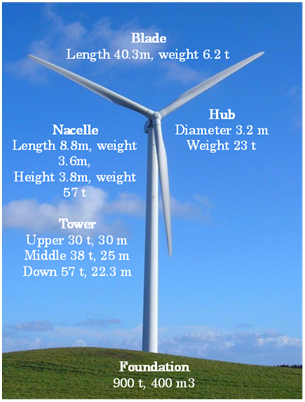Project Introduction
The Salkhit Wind Farm Project
Mongolia’s energy demand has been increasing by 8 percent per year for the past several years.Urban development and exploitation of large mining deposits are expected to sharply increase energy consumption in the near future. Such demand can only be met through the newly established domestic production of electricity, including from renewable and non-polluting sources such as Clean Energy’s 50MW Salkhit Wind Farm. This cutting edge project that building first wind farm connected to the Central Network in Mongoliabrings significant contribution to the electricity supply, and utilizes the most advanced technologies to create long-term, sustainable value for the local communities and the nation as a whole.
Salkhit Mountain and Shar Huvi Mountain range located in SergelenSoum of TuvAimag, is the nearest windy land area with wind resource potential to the Mongolian capital city of Ulaanbaatar. Based on wind resource assessment that conducted for several years covering 12,800 hectares of the territory, we settled in the current location as a project site for wind farm. The Salkhit Wind Farm is expected to save 1.6 million tons of fresh water and 12250 thousand tons of coal from being used every year, thus preventing the emission of 1780 tonne of CO2 equivalent into the atmosphere.

Development:
Wind resource measurement and analysis on the Salkhit Mountain and Shar Huvi mountain range was undertaken since 2005, for a total of 6 years of data collected. Typically, it is a standard in the wind industry to collect wind resource measurements on a proposed site location for between 3-6 years before a decision can be made on whether or not the site will be commercially viable. Clean Energy installed five modern measurement stations manufactured by the NRG Systems in the USA and used “Wind Pro 2.5” software made in Denmark for processing the measurement data and calculating the installed capacity of electricity generation of the wind farm. Wind data been collected from the site at first year was compiled and assessed by Global Energy Concepts of the USA; further Clean Energy continued the wind resource analysis independently.
Clean Energy also contracted with Black &Veach, one of the world’s foremost environmental consultants, to undertake a detailed environmental impact assessment (EIA) for the proposed project on the Salkhit site. A later feasibility study undertaken in 2011 by Clean Energy demonstrated the commercial and technical viability of the Salkhit Wind Farm Project, and Clean Energy proceeded with its plan to build Mongolia’s first wind farm.
In order to accelerate the construction of the farm and ensure its timely completion, Clean Energy undertook a number of construction activities during the development stage of the wind farm. Included was the construction of a28 km 110 kV double circuit high voltage transmission line between the Nalaikh substation connection point to the Central Network and the Salkhit site where a new substation will be built connecting the wind turbines to the grid. Clean Energy also constructed a11.5 km new road connecting Mongolian highway A0101 to the Salkhit site, a new railroad crossing to allow the large turbine components to bypass the railway line, and conducted a soil survey and analysis at the site.
The Millennium Challenge Account of Mongolia (MCA-M) has also been a key player during the development of the Salkhit Wind Farm. MCA-M is working with the government of Mongolia to undertake and fund an upgrading of the Nalaikh substation and is funding the installation of fiber optic cables from Ulaanbaatar to Nalaikh for use by the national transmission and distribution companies.
Construction:
 The Salkhit Wind Farm will be comprised of 31 wind turbine generators (WTGs), each with a 1.6MW(1600kW) capacity manufactured by General Electric, one of the largest wind turbine manufacturers in the world. The 31 WTGs (pictured here), will be transported, erected and installed by Leighton LLC of Mongolia, who will also undertake all of the site construction work including roads, foundations, cabling and building the Salkhit substation. Sgurr Energy LLC was further selected to act as technical advisor to the project.
The Salkhit Wind Farm will be comprised of 31 wind turbine generators (WTGs), each with a 1.6MW(1600kW) capacity manufactured by General Electric, one of the largest wind turbine manufacturers in the world. The 31 WTGs (pictured here), will be transported, erected and installed by Leighton LLC of Mongolia, who will also undertake all of the site construction work including roads, foundations, cabling and building the Salkhit substation. Sgurr Energy LLC was further selected to act as technical advisor to the project.
Design works for the project began at the end of 2011 and continued through early 2012 along with the procurement of key items. Main construction works on the sitestartedin April 2012 as the weather in Mongolia began to warm up, snows on the site subsided, and machinery was able to start accessing the site again. Major construction works include:
- the construction of WTG foundations,
- the erection, installation and commissioning of the WTGs
- the building of gravel roads for access to the site and roads between turbine locations,
- the construction and preparation of areas surrounding the turbines where the crane and turbine pieces will sit,
- the digging of trenches for cables and installation of 35 kV cables connecting each of the turbines to the Salkhit substation
-
the construction of the Salkhit substation and installation of all electrical equipment needed for connecting the WTGs to the grid
